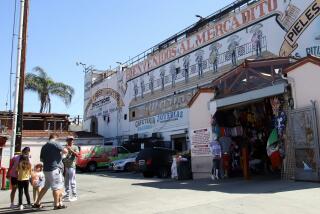Kodiak Sees Growing Latino Community : Ethnic groups: Long a home to migrant workers, this Alaskan fishing port is attracting more immigrants from Latin America.
- Share via
KODIAK, Alaska — Take a look at Gabriel Tirado Saravia and you’ll see the changing face of Kodiak--one of America’s busiest fishing ports and long a home to migrant workers from around the world.
Eleven years ago, Tirado, just off a plane from Mexico, started work at the Western Alaska Fisheries cannery in Kodiak, earning $6.50 an hour on the “slime line,” where fish heads and guts are removed.
“When I came from Mexico I was one of the poorest persons you could see,” said the 32-year-old from La Moncada in Mexico’s Guanajuato state.
Today, Tirado is a supervisor, earning about $50,000 a year.
A decade ago, most foreign cannery workers in Kodiak were Filipinos. Today, many are of Latin American descent.
Many Filipinos have moved into restaurant, taxi and other businesses, and belong to the Filipino social association or the Filipino Lion’s Club.
At Western Alaska Fisheries, where 125 workers were on the job in June, 63 were Filipino, 53 were Latino, 24 were Caucasian and 1 was Eskimo. Of the Latinos, a little less than half were Mexican, just under half Salvadoran, with workers also from Peru, Panama and Cuba.
Jeff Silva, a longtime Kodiak resident whose family owns land in Nicaragua, likens Kodiak’s Latino community to a “ ‘Star Wars’ bar--we have people from all the galaxies.”
“There really has been quite an influx of Latinos in the last few years,” said Kelly Law, general manager of KMXT, a public radio station that for the past year has broadcast “Ritmo Latino,” a mixed program of Latino music and information on Saturdays.
Virtually all of the show’s volunteer deejays work in the canneries.
Some Latinos find permanent work and settle down. Others work for a while, then return to their homelands or move elsewhere.
One saving up to return home to Mexico is Javier Pickering, 36. On a recent day, he worked a 12-hour shift at one cannery, then walked across the road for a second 12-hour shift at another. The next day, he worked 8 hours before volunteering as a deejay on “Ritmo Latino.”
But few make out as well as Tirado, and some don’t make out at all.
Milk runs $4.29 a gallon. Rents for Latinos, who often jam themselves a dozen at a time into substandard two- and three-bedroom apartments, are $150 per person. Some work two or more jobs.
Latino workers are more isolated in the community than their counterparts of other nationalities, Silva said.
“You’re dealing with a population that is just beginning to connect with one another,” he said.
But it is hard to determine just how big the Latino population is.
The Census Bureau’s 1990 count found 663 Latino people living in Kodiak Island Borough, 407 in the city of Kodiak, which had a population of 4,756. That was up from 304 Latinos in 1980, including 196 in the city.
Latinos often are undercounted in census reports, especially if they are in this country illegally. Silva estimates Kodiak’s Latino population at 1,000.
More to Read
Sign up for Essential California
The most important California stories and recommendations in your inbox every morning.
You may occasionally receive promotional content from the Los Angeles Times.













